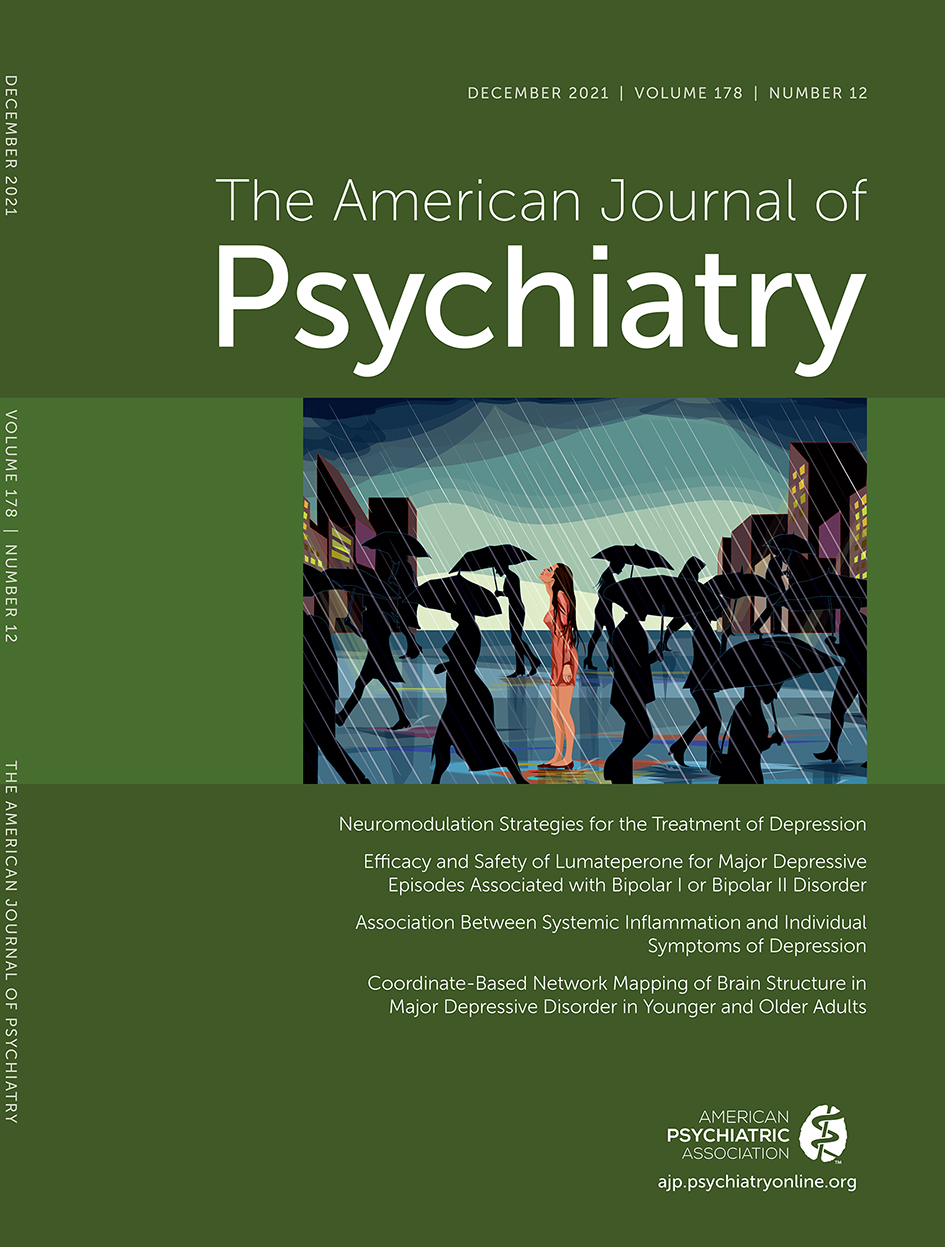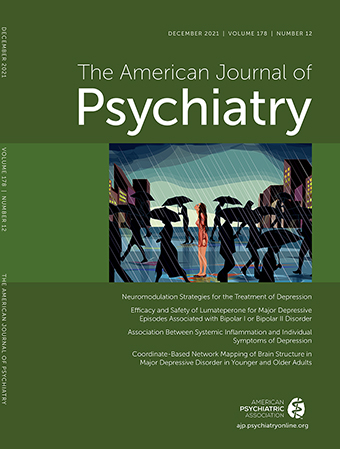Increased peripheral inflammation in depression is an incontrovertible biological finding that has been replicated not only by dozens of studies but also by recent meta-analyses bringing together many thousands of depressed patients (
1,
2), and by our large study in the UK Biobank in almost 27,000 depressed individuals (
3). Across these sets of evidence, inflammation, measured through the clinically relevant biomarker C-reactive protein (CRP), is elevated in depression even after adjusting for obvious confounders such as age, sex, body mass index (BMI), smoking behavior, alcohol consumption, antidepressant use, and a history of adverse childhood experiences, low socioeconomic circumstances, and ill health.
The article by Frank et al. (
4) in this issue of the
Journal further adds to this large body of evidence by presenting meta-analytical data from 15 population-based cohort studies comprising 56,351 adults, of whom approximately 14% have elevated depressive symptoms. Again, the authors find an association between elevated depressive symptoms and increased CRP that is independent of age, sex, socioeconomic position, smoking behavior, alcohol consumption, physical activity, BMI, chronic medical illnesses, and adverse childhood experiences. However, crucially, this study also helps us in understanding whether this biological abnormality is relevant to all, or just some, depressed patients.
In fact, one question that is still unresolved in the field is whether this increased peripheral inflammation represents brain-based, causal immune mechanisms that are operating across all depressed patients (“a little in all”), or whether it signals the existence of a specific subgroup of depressed patients with inflammation (“a lot in a few”).
The question is not trivial. The ultimate aim of measuring inflammation in depression is to have tools for personalized psychiatry, using blood-based immune biomarkers to predict treatment outcome with current antidepressants and to identify patients who are more likely to benefit from adjuvant strategies, and especially anti-inflammatory strategies, such as repurposed medications (
5) and nutritional interventions (
6). And this is where statistical distribution and clinical relevance seem to produce contrasting findings.
The aforementioned meta-analyses and epidemiological studies clearly describe increased inflammation in depression, not as a feature of a subgroup but rather as a continuous distribution of increased CRP levels that is “shifted to the right” (
1,
3), while clinical studies tend to identify a subgroup of patients with inflammation having CRP values above the established threshold of 3 mg/L, indicating low-grade inflammation. This group represents around 20%−25% of lifetime depressed patients (
1,
3), and around 25%−30% of acutely ill depressed patients, especially if treatment-resistant (
7,
8). Moreover, clinical trials with anti-inflammatory medications show that this strategy is effective only in depressed patients with higher CRP levels, above 3 mg/L or possibly even above 5 mg/L (
5,
9).
And this is where the study by Frank et al. really helps us throw some light on this key question.
Frank et al. find that CRP level is most strongly associated with physical and cognitive depressive symptoms, and least associated with emotional depressive symptoms. Specifically, they find that elevated CRP levels are associated with an increased risk of experiencing the four physical symptoms “changes in appetite,” “felt everything was an effort,” “loss of energy,” and “sleep problems,” and the cognitive symptom “little interest in doing things.” For four exclusively emotional symptoms (bothered by things, hopelessness about the future, felt fearful, and life had been a failure), they find no evidence of an association with increased inflammation. In further post hoc analyses, the authors confirm the existence of a specific subpopulation of depressed patients characterized by both elevated CRP levels and higher severity of these “inflammation-related” depressive symptoms.
These results are both biologically and clinically relevant.
Biologically, the authors present data that are consistent with knowledge derived from studies in people who develop depression
caused by increased inflammation due to immune therapies. In the classic model of “inflammation-induced depression” that appears during chronic immunotherapy with interferon alpha for cancer or for hepatitis C, studies have clearly indicated that the clinical depressive picture starts with a neurovegetative syndrome characterized by psychomotor slowing and fatigue, and evolves into a clinical syndrome associated with a reduction of dopamine-dependent metabolic activity in the basal ganglia that leads to fatigue, reduced psychomotor speed, and anhedonia (
10,
11). It is very likely that these same biological abnormalities underpin the coexistence of increased inflammation, increased physical symptoms, and decreased interest in doing things, described in the subpopulation identified in the study by Frank et al. This seems to indicate that inflammation is present
a lot, in a few.
However, the study also points to another important clinical consequence, perhaps one that is obvious when we meet patients in our clinics but that we seem to forget when we recruit them into clinical studies: that not all depressed patients are the same.
The population prevalence of each depressive symptom in the Frank et al. study varies so much—from 1.1% for suicidal ideation to 21.5% for sleep problems—that we could instinctually perceive, albeit not numerically measure, the multitude of combinations and of severity profiles, so that no two patients would ever sound alike when asked what depression feels like to them. Some will feel it more in their thoughts and emotions, and some more in their body and physical sensations, with innumerable permutations.
Depressed patients, however, will often—perhaps always—experience some level of severity, even if just mild, for all symptoms, especially in the midst of an acute relapse that is moderate or severe. And it is possible, although of course only a hypothesis at this stage, that inflammatory mechanisms are operating to generate these physical and cognitive symptoms in all patients, even if the inflammatory mechanisms, operating at the interface between the brain and the periphery, are so subtle that they cannot be picked up by the blunt instrument of measuring peripheral levels of immune biomarkers. So, it is possible that inflammation-related brain mechanisms are relevant to disruption of energy, fatigue, and hedonic state in all depressed patients: a little, in all.
This complexity enriches the concept of personalized psychiatry.
Of course, it confirms the notion of a subgroup of depressed patients who could potentially be helped by anti-inflammatory strategies. If stratifying only by higher CRP level is enough to detect statistically significant beneficial effects on depressive symptoms, imagine what we would find if we stratified and enriched for both high CRP and high somatic symptoms and anhedonia? Perhaps even stronger antidepressant effects.
Second, it potentially widens the criteria for stratification that we should be using for studies using anti-inflammatory strategies. At the moment, there might be patients with high somatic symptoms and anhedonia who could benefit from this approach yet are not included in the studies, because they do not have measurable increased peripheral inflammation. It is possible that subtle immune mechanisms are still operating at brain levels in these patients, and thus that they could benefit from an anti-inflammatory strategy.
But, most importantly, somewhere in the noise of the negative and conflicting findings of some of the past (or even future) clinical trials with anti-inflammatory strategies, there could be hidden improvements in one or two specific physical and hedonic symptoms in a large number of individuals: an improvement that does not surface through the analyses required for demonstrating clinical efficacy, as it is lost when averaging changes in all depressive symptoms, especially if some symptoms—the more emotional ones—are untouched or perhaps even worsened (
9) by anti-inflammatory strategies.
And this is why I enjoyed this paper so much. It confirms both models. Inflammation in depression indeed may be increased “a little in all” and “a lot in a few.”

